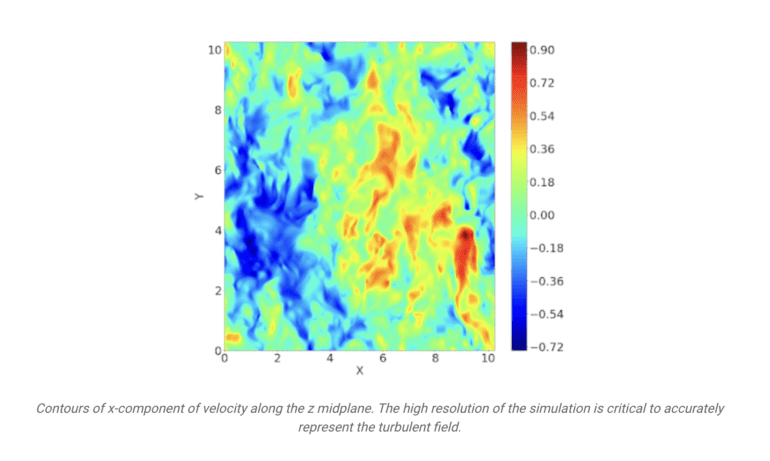TL;DR:
- Google AI introduces a groundbreaking TensorFlow simulation framework for fluid flow analysis.
- Computational fluid dynamics (CFD) is vital in various scientific and industrial domains.
- High-performance computing (HPC) systems have accelerated the capabilities of CFD.
- Direct numerical simulation (DNS) is a powerful tool for understanding turbulent flows.
- The new simulation framework harnesses TPUs and TensorFlow for enhanced scalability and performance.
- It maintains accuracy through TPU-native single-precision floating-point arithmetic.
- Validation includes canonical 2D and 3D Taylor-Green vortex simulations.
- Benchmark problems, including homogeneous isotropic turbulence, are incorporated.
- Simulations of turbulent flows exhibit strong statistical alignment with benchmark solutions.
- Four test scenarios affirm a second-order accuracy level.
Main AI News:
In the realm of fluid mechanics, computational fluid dynamics (CFD) has been the cornerstone for understanding and solving complex problems related to fluid flow and heat transfer behavior. Its applications span across various scientific and industrial domains, making it an indispensable tool for advancements in technology and innovation.
From optimizing wind turbines and power plants in the energy sector to refining manufacturing processes through precise mixing and chemical analyses, CFD leaves no stone unturned. It aids in the realms of oceanography and weather forecasting, helps in structural analysis and flood modeling for civil engineering projects, and contributes to the creation of energy-efficient buildings in the construction industry. Additionally, CFD finds its place in aerospace and automotive engineering, where it plays a pivotal role in enhancing aerodynamics and engine performance.
The prowess of CFD has grown exponentially, thanks to remarkable advancements in computing algorithms, physical model development, and data analytics. The advent of high-performance computing (HPC) systems has further accelerated progress, providing faster and more efficient solutions for high-fidelity flow simulations. These simulations, with their increasing resolution and ability to handle complex physical processes, have revolutionized our understanding of fluid dynamics.
Turbulence, a ubiquitous phenomenon in environmental and engineering fluid flows, has been a focal point of study. Direct numerical simulation (DNS) has emerged as a powerful tool for comprehending turbulent flows. Unlike other methods, DNS accurately portrays the unstable three-dimensional flow field without approximations or simplifications. However, the computational demands of DNS are substantial, necessitating immense processing power to depict fluid-flow patterns over various geographical scales accurately.
To address this computational challenge, researchers have introduced a groundbreaking simulation framework that leverages the power of Tensor Processing Units (TPUs). This innovative framework harnesses cutting-edge advancements in TPU hardware design and the TensorFlow software, showcasing remarkable scalability to adapt to diverse problem sizes, ultimately enhancing runtime performance.
At its core, this framework relies on the graph-based TensorFlow as the programming paradigm. Extensive numerical and analytical studies have been conducted to assess its accuracy and performance, with a particular focus on the impact of TPU-native single-precision floating-point arithmetic. The algorithm’s validity and implementation have been verified through canonical 2D and 3D Taylor-Green vortex simulations.
Throughout the development of CFD solvers, idealized benchmark problems have played a crucial role. Many of these benchmarks, including the study of homogeneous isotropic turbulence, have been integrated into this research endeavor. Homogeneous isotropic turbulence, characterized by statistical properties invariant under translations and rotations of the coordinate axes, serves as a fundamental benchmark for turbulence analysis. To tackle this challenge, the researchers employed a fine-resolution grid encompassing eight billion points.
The research team delved into simulating turbulent flows across two specific configurations: decaying homogeneous isotropic turbulence and a turbulent planar jet. The outcomes were nothing short of remarkable, with both simulations demonstrating strong statistical alignment with benchmark solutions.
In their pursuit of rigorous validation, the researchers conducted four distinct test scenarios, spanning 2D and 3D Taylor-Green vortex flow, decaying homogeneous isotropic turbulence, and a turbulent planar jet. These simulations yielded results untainted by round-off errors, affirming a second-order accuracy level.
Conclusion:
Google AI’s groundbreaking TensorFlow simulation framework for TPUs holds immense potential for the market. This innovation promises to revolutionize the field of computational fluid dynamics, making it more accessible and efficient for a wide range of industries. Businesses can anticipate improved efficiency, accuracy, and scalability in their fluid flow simulations, leading to advancements in product design, energy efficiency, and environmental modeling.

